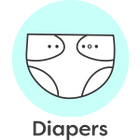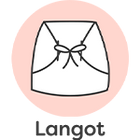For every milestone a baby achieves, the parents are the biggest cheerleaders and the happiest about it. But this achievement is as much of the parents as it is of the baby. To help the baby achieve each developmental milestone, support, correct information, and parents' awareness are vital. Among all these milestones your baby will achieve, the biggest and probably the most difficult one will be Potty Training!
While some toddlers might take just three days to get potty trained, some might take weeks or even months to master potty training and move from diapers to potty training pants and eventually to regular underwear. Every child has their own pace, and it is OK to take longer than others. In this article by SuperBottoms, we will help you know if your baby is ready for potty training, when and how to start potty training, what challenges you might face during the process, and how to overcome those challenges! Read on!
Is Your Baby Ready for Potty Training?
Wondering what is the ideal potty training age? Does the age to potty train a girl differ from that of a boy? What accessories will you need to begin potty training? Well, while we will answer ALL those answers later in this article, it is first essential to know whether your baby is ready to be potty trained! Here are some crucial pointers for understanding your baby's readiness and being at potty training age.
1 ▪ Your baby is pooping regularly and usually around the same time every day.
2 ▪ The number of diapers used daily has reduced, and your baby has formed a pee and poop pattern. The nappy or diaper is dry for over 2 – 3 hours; the gap between two pee episodes is at least 2 hours.
3 ▪ Your baby can follow verbal directions such as "Come here", "Sit here", Pull your pants up", "Wash your hands", etc.
4 ▪ Your baby can communicate his needs verbally or using signs. For example, they can tell you when they are hungry, thirsty, want to poop, want to be picked up, etc.
5 ▪ Your baby likes to be appreciated for doing some easy tasks independently.
6 ▪ When other adults in the house use the toilet, your baby shows interest in using the seat and the overall process.
7 ▪ Your baby gets irritated when he poops in the diaper or if the diaper is wet or soiled.
8 ▪ Your baby is comfortable and familiar with the potty seat and can sit on it.
If the answer to most of the pointers mentioned above is yes, congratulations, your baby is ready for potty training. It is time to move them from diapers to baby training pants.
OK, The Baby Is Ready. Are You?
So now we know how to know if your baby is ready for potty training. But what about you, dear parents? Are you ready? Here is a list of things you must consider before you begin the potty training process.
1 ▪ If you are not installing a mini potty seat or getting a portable baby potty, you will need one. A baby potty seat is cheaper and needs to be placed over the regular commode and ready for your baby's little bum.
2 ▪ Your little one might still not be able to climb up the potty seat comfortably; thus, you will need a step stool or a footrest to place in front of the potty chair so your baby can climb the potty seat independently.
3 ▪ Pull-up style potty training pants or potty training underwear. These are extremely important for potty training your baby. If you keep your baby in a diaper, they might be unable to identify the dampness and thus the urge to pee on their own. Potty training pants can hold up to one pee and make your baby feel wet; therefore, they would rather pee / poop in the pot than feel this irritation. You will need at least 3 of the best toilet training pants for the day and 2 spares for the nighttime if your baby is entirely off diapers and on baby training pants.
4 ▪ Some exciting books, videos, and songs to introduce them to potty training! It will make the process fun for them.
Some Useful Tips for Potty Training Your Baby
1 ▪ All children have some unique cue they show when they are about to poop. Some kids go behind a curtain, some hide below a table, and some make a 'poop' face. You must identify that cue and ask your baby if they want to poop. This will help them learn to recognise the cues and eventually ask you to take them to the potty seat when they have an urge to pee or poop.
2 ▪ If your child fears using the potty seat, do not force them to do so. Slowly make them comfortable with the seat, let them spend some fun time in the toilet with no agenda of pooping in the potty seat, and let them sit on the chair even when you are not teaching them where to poop.
3 ▪ Create and maintain a schedule. Based on the time your baby poops, which would usually be after a particular meal in the day, take your baby to the potty seat and ask them to poop there instead. Take them to the toilet every few hours to pee. Do not be harsh, but be stern about following the schedule. This way, your baby will know what is expected of them and slowly become a habit.
4 ▪ Encourage your baby to do all potty training-related tasks independently and celebrate each achievement enthusiastically. This will motivate them to make this a habit. On the other hand, if there are accidental pees and poops in the potty training pants, do not get angry or show disappointment. Be gentle with them.
5 ▪ Use toilet training to teach your kids other hygiene and self-care-related habits . Some habits you can begin with early on are washing hands, washing your face, wiping your hands, and applying moisturiser on your hands.
Some challenges You Might Face
1 ▪ Anxiety and resistance to using the toilet seat – Seeing a hole on which you are made to sit might be scary for a child. What if I get sucked into this hole, will I fall inside? There might be questions their baby brain might be trying to process. The first step in dealing with this problem is to acknowledge it. Please do not laugh at them or trivialise their fears. You can sit on the seat and show them that nothing happens. You can also show them how the flush works and is harmless by flushing a small piece of tissue or other flushable material.
2 ▪ Does not want to pee / poop outside the home – Sometimes, even we as grown-ups are hesitant to use public toilets. The easiest solution to this problem is to clean and carry the potty seat top wherever you go. It can easily sit on top of any potty seat, and your baby is ready to pee or poop quickly.
3 ▪ Daytime accidents or nighttime bedwetting – Be patient, calm, and realistic. Whenever we learn a new skill, we all commit mistakes and slowly master that skill. Give your baby the same patience and leverage. The best way to avoid bedwetting is to give your baby fewer liquids a few hours before bedtime, take them to the toilet right before they sleep, and, after a few hours, wake them up to take on the toilet seat to pee till that becomes a habit.
|
Limited Time Offers + Special Gift Sets! Now or never Super SALE is live on the SuperBottoms website! Take advantage of unbeatable value deals on our UNO Cloth Diapers, Baby Essentials, and more. Looking for the perfect present for a newborn or a toddler? Explore our thoughtfully curated Gift Sets & Combos — safe, skin-friendly, and oh-so-cute! A bundle of love for little ones and a delight for parents. HURRY — Deals and Gift Packs are live only till stocks last. Don’t miss the chance to stock up and share the joy! |
Potty training is an essential milestone in a toddler's life, and it can be a complex process for both parents and children. However, with the right approach, time, and preparation, parents can smooth the transition from diapers to pants. It is essential to understand the signs of readiness and choose the right time to start potty training. Parents must also have the necessary tools and resources to make the process comfortable for their child. By following a step-by-step guide and being patient with your child, parents can celebrate their child's success and maintain progress over time. Remember that every child has their own pace, and being supportive and encouraging throughout the potty training journey is essential.
Common Questions Parents Ask (FAQs):
Ques 1. What is the best age to start potty training?
Ans: There is no one particular answer to this question. Every child develops at their own pace. However, many children are ready to start potty training between 18 months and three years old. It is essential to look for signs of readiness mentioned in the above article, such as showing an interest in the potty, being able to follow simple instructions, and having regular and timely bowel movements.
Ques 2. How long does potty training take?
Ans: The time it takes to potty train a child varies depending on the child's readiness, temperament, and potty training method. Some children may take only a few days to master potty training, while others may take several weeks or months. Parents must be patient and consistent during the process and not rush their children.
Ques 3. What should I do if my child is resisting potty training?
Ans: It is not uncommon for children to resist potty training at first, and there are several reasons why this might happen. Some children may fear the toilet or be anxious about using it. Others may be attached to their diapers and find it challenging to transition. If your child resists potty training, being patient and gentle with them is essential. Try to make the process fun and positive by using rewards and praise. You can also try different methods or approaches until you find one that works for your child.reach
Message from SuperBottoms
Hi there, new parents! SuperBottoms brings you doctor-recommended cloth diapers — the best rash-free diapering solution for your baby’s sensitive and delicate skin. Unlike disposable diapers loaded with chemicals, our newborn cloth diapers, when used and washed properly, can help eliminate the risk of diaper rashes. SuperBottoms offers a wide range of safe, skin-friendly essentials for the whole family — including Reusable Cloth Diapers, Diaper Pants, DryFeel langots for diaper-free time, Padded Underwear for potty training, SuperSoft Underwear for everyday comfort, Joggers for playful days, and Period Underwear for women. Not just for everyday use, SuperBottoms products also make the best gifting choice for babies — thoughtful, eco-friendly, practical, and loved by parents. Now available on Amazon, Myntra, Flipkart, FirstCry, Zepto, Swiggy and Blinkit




























































































